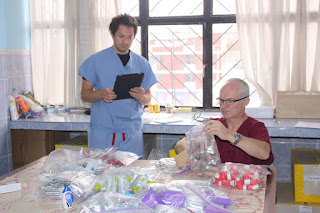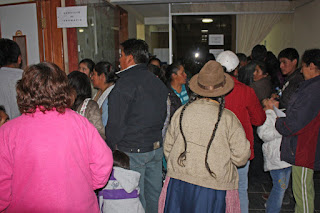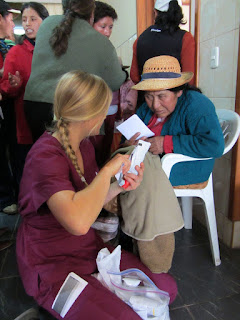I awoke this morning with great anticipation for our first day at the clinic. As I put on my scrubs my excitement grew more pronounced. We met a number of others from our group at breakfast in the hotel and learned that the rest of our group including Rosa would not be arriving at the airport in Cusco until noon. So we sorted through the suitcases we had brought with us, separating out those that would come with us to the clinic from those that will be donated later when we visit some local communities. Then Mike, who works for Roche, recruited me to join him and the pharmacist, David, in my first assignment as interpreter. They were going to the clinic right away before any of the others to await an expected delivery of meds and to begin setting up the pharmacy. Moments later I hailed a taxi near the Plaza de Armas and the three of us were on our way. I asked the taxi driver if the clinic is close enough to walk to from our hotel since both David and I had been considering our own two legs as an alternative commute. He discouraged us saying it is too far and too dangerous. We crossed to the opposite side of the city and began to climb into one of the barrios whose streets finger up the hillsides surrounding Cusco like a steady creep of habitation. Stray dogs populated the quiet lanes of the neighborhood in every possible combination of breed and appearance. We passed two especially scruffy looking dogs nuzzling a third who was balanced sleepily on a doorstep. Women carried impressive loads on their backs or set up simple snack stands in front of their open doorways. When we arrived at the Policlinico Belen our taxi driver, a young man of about 30, accepted our payment and then said quietly: "excuse me, another quick little question . . . I´ve been having this pain in my leg when I play soccer . . . " Apparently wearing scrubs provides an open invitation for people who are in need.
 |
| Doctors' examination rooms. photo by JG |
The door to the Policlinico was open but at first we could not find anyone and the whole 3-story building seemed abandoned except for some random Japanese-sounding music emerging from inside a sealed closet. It is a fairly basic building, but it was much more than I had expected we would have to work with. When we finally found one of the nuns who usually organizes the daily ins and outs of the clinic (there normally are Peruvian doctors that visit/work here) she welcomed us with highest enthusiasm and showed us through the various rooms that had been prepared for our six doctors. Each room was fairly simple and basic: a desk, a couple of plastic chairs, a barely functional bathroom closet, an examination table-bed and some simple screens to create separation between the doctors and their patients that shared the same room. The nuns had carefully prepared each space: a sign with each doctor´s name and specialty hung above the door (e.g. "Doctora Katarina Gundling, Medicina Interna"), a box of tissues, wooden tongue depressors, examination gloves, a stack of paper to use for prescriptions . . . an that was it! The doctors would have to rely on their skills and knowledge and not on the aide of equipment or supplies. What would within the next couple of hours become our pharmacy was a fairly small room containing a large table, a countertop, and some empty shelves. I was surprised and delighted to see a number of boxes containing a variety of medicinal plants, some whose names in Spanish I could recognize, some I´d never heard of before. It seems that what we deem "alternative" or "folk" is a fairly common mode of treatment here at the Policlinico.
 |
| David and Mike in the pharmacy. photo by Alison Nichol |
 |
| The vitamin section. photo by Katherine Gundling |
David, Mike and I immediately got to work sorting medicines, vitamins and other supplies that had arrived with our group. I would tell David what each item was and he would tell me where he wanted it. Quickly the shelves filled and our insta-pharmacy was shaping well. Eventually the others arrived and everyone helped out in some way but it still took us several hours to sort through the dozens of suitcases we had collectively brought. Two doctors from Lima arrived, as well as Rosa and the rest of our group fresh from the airport. My cousin and I were pulled aside to be given special training on the various inhalers we would be dispensing at the clinic, learning how to explain confidently in Spanish the proper way to use each of the different models. In the early afternoon we gathered for a lunch that the nuns had kindly prepared for us and received our work assignments for the afternoon. I would spend the afternoon as interpreter in the pharmacy.
Soon after lunch our first patients began to arrive. I was happy to see the first prescription included some of the vitamins I had brought from Whole Foods! Each of the doctors had 20 patients on their list and we started at about 3pm. With five American doctors and the two Peruvian doctors from Lima, the pharmacy was completely slammed. I would open the door to a deep throng of people all pushing their prescriptions toward me. "Recetas? Recetas?" I would call out, and immediately find a stack of them in my hand. As David, Mike and a couple of the teen girls (daughters of some of the doctors and volunteers) counted pills and prepared each prescription, I would grab one that was ready and head back out into the chaos of pressing bodies. After calling out the patient's name and finding the correct recipient I would explain to each of them very carefully how to take the medicine correctly. I often repeated myself slowly to make sure they understood exactly what to do. Each time I came out to translate a prescription to its recipient I would find myself close-circled by a crowd of curious faces. Everyone wanted to see what everyone else was getting, sometimes repeating my words to the patient if they didn´t immediately get it: so it became a collaborative project. I was especially amused and endeared by the enthralled audience each time I demonstrated one of the inhalers. It was an intense afternoon, running back and forth translating constantly, trying to keep the crowd of people outside the pharmacy from busting down the door (eventually we just left it open, but I sill had to maintain some crowd control . . . a line? What's that?). We each worked like we had twenty arms and interacted with every patient that had gone through every doctor. Needless to say, the time flew by. Though it took us a little while to find our groove in all the chaos and bustle, those of us in the pharmacy did eventually find a good rhythm and became smooth in our teamwork. It was always fun to dispense one of the prescriptions that arrived from my aunt. There was hardly time for anything but a blur of activity and communication. I loved the intensity of it all and managed to keep my focus even when I was inundated with "mamita, por favor . . ." each time I opened the door and through the
 |
| The scene outside the pharmacy. photo by Alison Nichol |
constant shower of questions: "doctorita, I forgot to ask the doctor when I was in the examination room about this pain in my back," or "doctorita, my sister has a lump on her leg . . ." or "doctorita my son . . ." I continually had to tell people "I'm sorry I'm not a doctor." A few people became a little pushy: "Where´s my prescription, I have been waiting so long . . ." dragging out their voice when they addressed me: "mamiiiiiiiita!" I had to assure them that we were working as fast as we could to get through the huge stack of prescriptions, that some were more complicated and therefore took longer than others, and to please be patient. Others showered me with intense gratitude, holding my hands, speechlessly kissing my cheeks, or saying "muchas gracias, muy amable." When one very old woman kissed my hands, I felt so very humbled.
 |
| How to use an inhaler. photo by Claudia Paya |
 |
| The pharmacy team. photo by Claudia Paya |
|
|
|
 |
| "148, 149, 150 . . ." photo by Alison Nichol |
 |
| Dr. Rosa Ten attending a patient. photo by Alison Nichol |
Many of the older people were bowed over from a lifetime of backbreaking labor, mumbling with age and gazing through eyes milked-over by sun damage or blindness. Their faces were a complex map of lines and folds. Children dodged through the legs of the adults with snot dried at their noses, dirt caked their hands and cheeks. Some offered the most dear and beautiful smiles one can encounter in this world, while others hid with shy eyes behind their mothers' colorful wraps. Others just stared with an intensity of expression that caused me to wonder what experiences and suffering they have already known in their relatively short time living.
 |
photo by Marie Hasnain
 |
| photo by Marie Hasnain |
 |
| photo by Marie Hasnain |
|
 |
| photo by Rosa Ten |
 |
| photo by Marie Hasnain |
 |
| photo by Marie Hasnain |
 |
| photo by Marie Hasnain |
 |
photo by Marie Hasnain
|
 |
| photo by Marie Hasnain |
One young mother had a prescription for each of her four children, including basic multivitamins for nutritional support and antiparasite drugs. Each time I came out of the pharmacy with a fulfilled prescription I could see her become increasingly light of spirit. After her, I delivered a prescription to a man standing with handmade wooden crutches who might have been about 40 years old, but looked 80. He held the pain medicine he had been given gratefully in his calloused and hardened hands, his eyes and face subdued beneath his ragged cap. It broke my heart to realize that when the medicine we give him runs out he will have to again experience the pain. This is the greatest difficulty in the work
 |
| Careful instructions. photo by Claudia Paya |
we are doing and I know it must be especially challenging for the doctors: to realize the
immense need and not even be able to scratch the surface given our short time and limited resources . . . to spend 20 minutes with a patient, to recognize a serious problem they may have, to do the very best we can given our limitations and then to never see them again . . . I can only imagine how much it must stretch the doctors mentally and emotionally. I think that perhaps the most
sustainable piece of our work at the clinic is the antiparasite medication that Sabrina, another one of the interpreters, gave to each and every man, woman and child that entered the clinic. She made sure that every pill was fully chewed and swallowed before planting a stamp on the hand of those who had received the treatment. This single dose will kill most (about 90%) parasites and will be effective for six months. We will be leaving a supply of these pills at the Policlinico so the people can return after half a year to receive the next treatment.
 |
| Clydene assisting patients in the hallway. photo by Marie Hasnain |
I was still translating for the last patient at the pharmacy when we were told "let's go, our bus is here!" and we had to hurry quickly, leaving the pharmacy in somewhat of a chaotic state. It was already long after dark and we returned to the hotel with a feeling of fullness from the intensity of the afternoon. My aunt Katherine was visibly moved by the cases she had seen and by the immensity of the need we are dealing with here (often the most
basic of needs). She seemed at the verge of tears throughout the bus ride back and we didn't sleep until late, talking and sharing our stories from the day.
















No comments:
Post a Comment